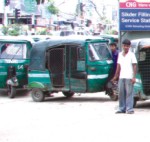|
Energy
Braving the CNG crisis
Farhana Urmee
 |
| Photo: zahedul i khan |
Yunus exchanges smiles with every pedestrian as he sells dates, cucumber and eggs in separate baskets on the open premises of a CNG filling station in Shyamoli in the city.
He seems happier than usual; not only have his sales gone up, he has also managed to find a nice place to sit in, an open place where even a small crowd can gather.
Yunus appreciates the government decision to keep CNG stations partially shut in Ramadan, making it possible for him to find a new place where he can get a crowd of customers bigger than his moholla's temporary bazaar.
As Yunus's sales keep soaring, behind him the CNG station, already suffering from low gas pressure, looks forlorn and deserted in the afternoon of 10th day of Ramadan, normally a busy time before the Muslim religious festival Eid-ul-Fitr.
It has been more than a week that the government decided to keep CNG filling stations shut for six hours everyday, starting from 3.00 to 9.00 pm, across the country.
The decision was taken with the objective to save around 40 million cubic feet of gas daily and utilise it in generating power up to two hundred megawatts for a country reeling from a severe power crisis.
To Md Yunus, the recent government move might have brought some luck temporarily but there are people for whom the move has cost their everyday income. These include CNG station owners and CNG drivers.
As Yunus is happily making his sales before Hafiza Filling Station resumes selling gas, a good hour and a half away, Rafiqul Islam arrives with his CNG.
“It will be a huge rush in an hour, private cars and auto-rickshaws will be fighting for their 'serial'. I've come earlier,” says Rafiqul.
Before this new move of the government I could give six to eight trips a day and earn at least Tk 500 every day excluding my daily Joma (Rent) of Tk 600 for the CNG, Rafiqul said.
“But the government's decision to keep CNG filling stations partially shut does not let me make the regular income home anymore,” he says adding that before Eid the CNG owner usually earns more and around Tk 800 per day.
“As CNG filling stations, already hit by low gas pressure, are closed for six hours a day in peak hours, even I have to switch off my engine for few hours daily since August 16,” he adds.
A CNG has to be refilled at least twice for a whole day operation while goods-laden vehicles need more gas that cannot be received due to low gas pressure.
“Gas pressure in a CNG station should be 15 psi (a unit measuring gas pressure) but we get only 8.50 to 10psi, which is unable to refill cylinder of any vehicle properly,” says Assistant Manager Rashed Sarkar of Shahanz CNG filling Station in Gabtoli.
“We had an income of Tk 3-3.50 lakhs daily which has come down to Tk 2-2.50 Lakhs due to the closure.”
Having ten individual nozzles for filling gas. Shahnaz Filling Station is still not incurring losses that would warrant layoffs. But for CNG stations like Hafiza Filling Station, where around 50 people work from administration to the machine operator level, keeping all its employees may become a challenge. The daily income of Hafiza filling station has already been halved.
 |
Photo: zahedul i khan |
The 40 machine operators (who help refill vehicles' cylinder) and filling station guard would be the likely casualties of any such lay off plan.
Technician of Hafiza CNG Filling Station Michael Molla says, “Considering the Eid ahead the owner may run the station currently but the owner would definitely rethink about number of its staff after Eid if the situation remains same.”
Rashed Sarker really fears the worst if the government sticks to its recent decision for long. Only a few days ago Rashed saw people getting into fights five times in a single day at his station merely over getting gas.
“People with their vehicles go crazy at the time of closing and resumption of the filling station. Everybody wants their turn first, and it becomes difficult to handle public's anger,” says a vexed Rashed.
The public's frustration stems from the severe curtailment of their mobility due to the partial closure. Kiron usually comes to his Sobhanbagh from Mirpur by bus, but the huge rush for public transport and long queues before iftar has made Kiron decide to look for alternative transport. But the CNG driver he approaches asks for 200 taka alluding to the gas crisis.
Reluctantly Kiron gets onto the CNG as he has no other option.
Kiron sees that the government decision is affecting his life by allowing yet another excuse for CNG drivers to charge more than the actual fare. Again his suffering does not lessen when he faces frequent power failure which the imposed interruption in gas supply was supposed to address.
Copyright
(R) thedailystar.net 2010 |
